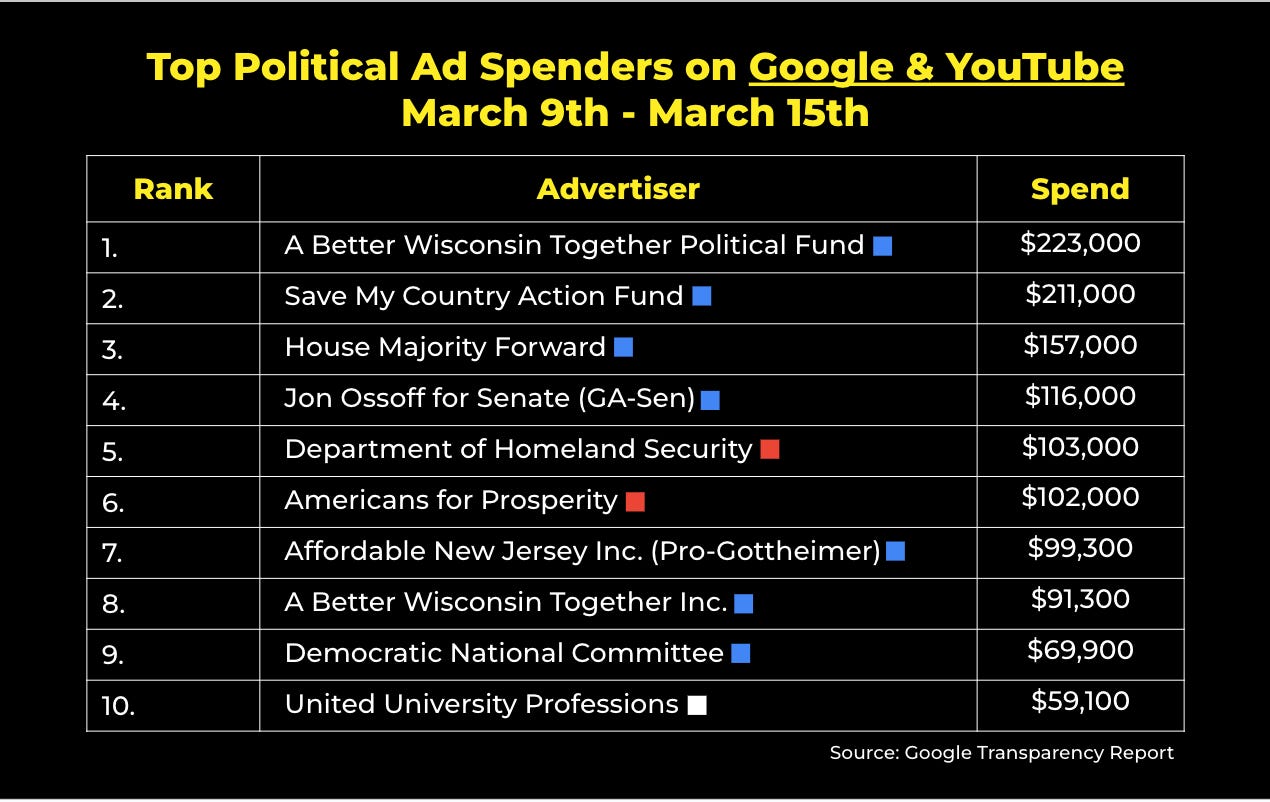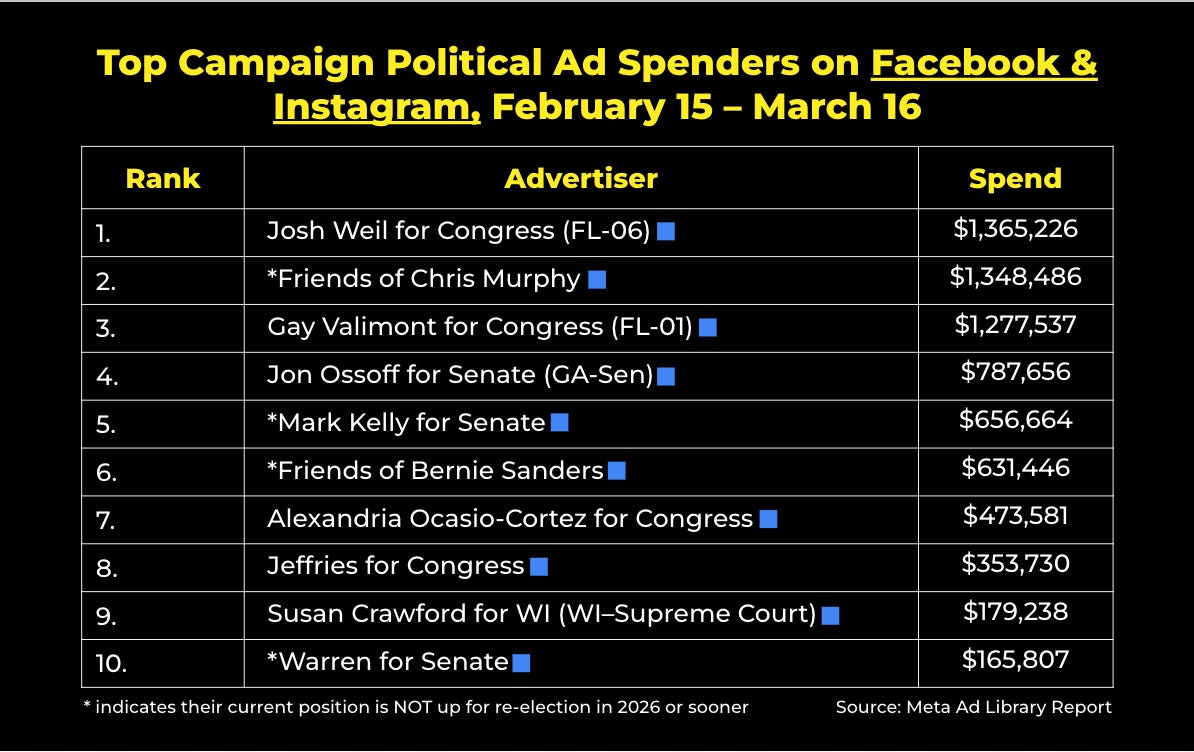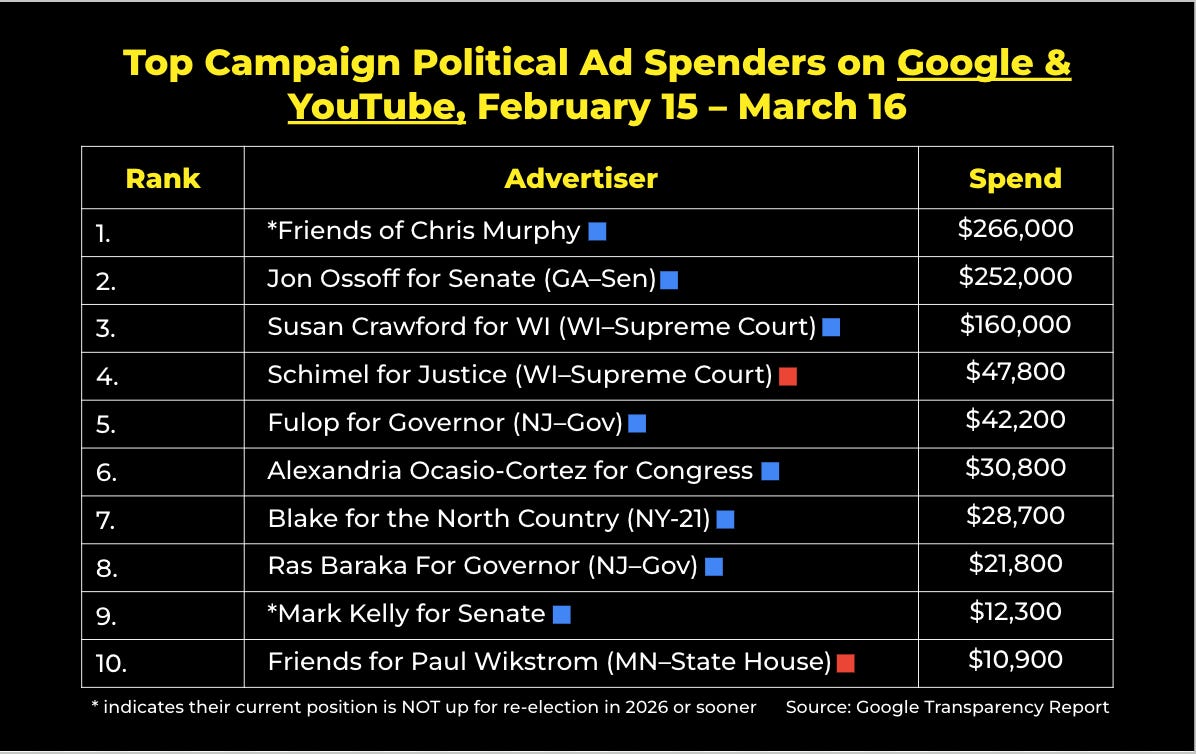Dems' Online Fundraising Playbook for Trump 2.0
Also inside: MoveOn and others take on DOGE in digital ads, AI will be able to write your IG comments for you, and more
This newsletter is sponsored by Ripple on Impact.
Over the past few weeks, we’ve been tracking the growing number of prominent Democrats who are running digital fundraising ads from their campaign disclaimers to ask for support as they stand up to Trump. This week, we’re doing a full breakdown of that trend and what exactly it means for our present moment, for 2026, and beyond. But first…
One more quick note: If you’ve ever wanted to guest-author FWIW, now’s your chance! We’re looking for mission-aligned folks working in this wild intersection of tech, politics, government, and media to share their wisdom with us. Check out this great example – and reply to this email if you’re interested!
Digital ad spending, by the numbers:
FWIW, U.S. political advertisers spent about $10.6 million on Facebook and Instagram ads last week. Here were the top ten spenders nationwide:
The ACLU appears to have launched a new Facebook + Instagram ad campaign demanding the release of Columbia grad student Mahmoud Khalil, including a full video taken by his wife during his arrest. The ads link to an ACLU petition and are running nationwide but seem to be primarily targeted at New York and California.
Both MoveOn.org and the Progressive Turnout Project are running Facebook + Instagram ads asking for support to stop DOGE from cutting PBS. Interestingly, they are a good case study in different tactics: MoveOn’s ads are more clearly geared toward fundraising, and Progressive Turnout Project’s lead to a petition, a poll, and then an ask – both, however, seem to be primarily targeted at people over 55 in NY + CA.
Meanwhile, political advertisers spent just over $2.5 million on Google and YouTube ads last week. These were the top ten spenders nationwide:
2024 Republican presidential candidate and Trump ally (and guy who was initially supposed to be part of DOGE) Vivek Ramaswamy, who is now running for Governor of Ohio, dropped $38,300 on Google + YouTube ads last week from his V-PAC: Victors, Not Victims. The ads tout his Trump endorsement.
On X (formerly Twitter), political advertisers in the U.S. have spent around $1.6 million on ads in 2025. According to X’s political ad disclosure, here are the top spenders year to date:
…and lastly, on Snapchat, political advertisers in the U.S. have spent around $216,900 on ads in 2025. Here are the top spenders year to date:
What’s trending on YouTube:
Unfortunately, our friends over at Tubefilter flagged that there are still some issues with the YouTube data (here’s the discourse over on YouTube’s issue tracker in case anyone is interested/needs updates) – but things should hopefully be back to normal very soon!
In the meantime, here’s what I’m reading about YouTube:
Lilly Singh Launches First-Ever Media Network for South Asian YouTube Creators
YouTube wants brands to run campaigns on Shorts, where logged-in viewership is up 25% year-over-year
Fundraising for Your Campaign Shouldn’t Feel Like Playing the Lottery
This month, ROI is running a 110% minimum ROI deal on text rentals and email sales for new clients. Working with a fundraising company shouldn’t feel like playing the lottery. Reach out to Ripple on Impact today to get started >>.
Dem’s Online Fundraising Playbook for Trump 2.0
We’ve been tracking a trend over here at FWIW for the past several weeks: prominent Democrats – especially those who are making a name for themselves by standing up to Trump 2.0 – have been spending TONS on digital ads from their campaign disclaimers/accounts to fundraise and ask people for their support as they push back on Trump.
It’s not unusual at all for candidates to fundraise off of major news moments – and the Trump admin seems to provide at least one of those every day. But the more unusual part about this? Many of the people fundraising from their campaign accounts aren’t even officially candidates – and aren’t up for re-election until 2028 at the earliest.
Some of the key figures we’ve been tracking and watching spending money week over week are Sen. Chris Murphy, Sen. Bernie Sanders, Sen. Mark Kelly, Sen. Elizabeth Warren, Rep. Alexandria Ocasio-Cortez, and Rep. Jamie Raskin. (NOTE: Both Rep. AOC + Rep. Raskin have been running ads about the Trump chaos, but both are technically in-cycle as House members.)
And it’s a trend that doesn’t seem to show any signs of stopping. Let’s take a closer look:
Here are the top political ad spenders on Facebook and Instagram over the past month looking solely at campaigns (note: not including any PACs that may be supporting candidates).
Here are the top political ad spenders on Google and YouTube over the past month looking solely at campaigns (note: not including any PACs that may be supporting candidates).
As I noted in the charts, the * indicates that a campaign account/disclaimer is spending on political ads but the candidate is not up for re-election in 2026 or sooner.
Elected officials are, of course, pretty much always fundraising (it’s something many people, including electeds themselves, have raised alarms about) – but this type of digital ad strategy, especially given the $$$ we are seeing spent on Facebook + Instagram ads, is more typical of a candidate who has an election approaching soon.
There are both big positives and some potential pitfalls to this strategy. On the plus side, running ads from their campaign disclaimers allows prominent Democrats to speak more freely, reaching a national audience with direct messaging. It also positions them as leaders willing to stand up to Trump and Musk at a moment when many voters are craving exactly that.
Another advantage is the immediate action these ads can provide – several urge viewers to donate to them as a direct way to push back against Trump. (There are also some more specific support asks, like the Friends of Bernie Sanders ad that mentions funding his Fighting Oligarchy tour.)
The potential downside? Most of the Democrats on the Senate side in particular who are running these ads – except Sen. Mark Kelly who is for re-election in 2028– were just re-elected in 2024 and aren’t up for re-election to their current position again until 2030. And grassroots fundraising is facing some significant issues, especially with Democrats’ tech woes and broader economic concerns. That makes it notable that a handful of high-profile Democrats who are not, to public knowledge, running for office any time soon are likely bringing in a large share of available grassroots dollars.
Donating to these folks who are running ads now will likely give them pretty major power of the purse over candidates in 2025 and 2026 who may not even have announced they’re running or had any chance to fundraise yet – which is a dynamic that most voters, even the read-in ones who are donating to them right now, are most likely not aware of.
Ultimately, this surge in intense off-cycle campaign fundraising seems to be a product of Trump 2.0 – and one of the few ways that Democrats can use this otherwise defeating moment to gain some power and resources. We’ll be watching to see how it unfolds.
Fundraising for Your Campaign Shouldn’t Feel Like Playing the Lottery
This month, ROI is running a 110% minimum ROI deal on text rentals and email sales for new clients. Working with a fundraising company shouldn’t feel like playing the lottery. Reach out to Ripple on Impact today to get started >>.
More from around the internet:
The Arizona Supreme Court is apparently tapping into AI: they’re partnering with a company called Creatify to build Daniel and Victoria, two AI-generated avatars that will deliver the news of every ruling issued by a judge via posts on the socials.
And speaking of AI, Instagram is apparently working on a tool that will have AI write comments on people’s posts for you. (Whether or not there was any need for that… remains unclear.)
The value of X/Twitter tanked after Elon Musk bought it and took over, but apparently, it’s been reported that the value *may* back up to the $44 billion he bought it for.
- is out with a fairly devastating but, in my opinion as a member of Gen Z 1.0, spot-on op-ed on how young people, shaped by COVID and the digital era, are crying out for help.
Gov. Gavin Newsom really, really wants tech CEOs to talk to him.
Our weekly clips round-up is back! Every Tuesday, paid subscribers will get a debrief on the stories about politics, tech, social media, media, and journalism you need to be tracking. If you haven’t signed up yet, you can right here ⬇️
That’s it for FWIW this week. This email was sent to 24,104 readers. If you enjoy reading this newsletter each week, would you mind sharing it on X/Twitter, Threads, or Bluesky? Have a tip, idea, or feedback? Reply directly to this email.










I don’t know who needs to hear this, but I feel it is a real problem when campaigns or other folks use surveys for the purpose of fundraising, ESPECIALLY when all the questions lead to “if you feel that way don’t you want to give us a bunch of money?”
Occasionally, I get sincere surveys but they are so few that my new rule is likely to be NEVER AGAIN.
If you want a donation just say so.
Oh wait, you FIRST have to establish TRUST. If you have a proven track record like AOC, Chris Murphy, or Pete Buttigieg then I will trust you with the few pennies I have to give.
Otherwise, show me. Don’t waste my time with a survey that leaves me feeling that I have been conned.